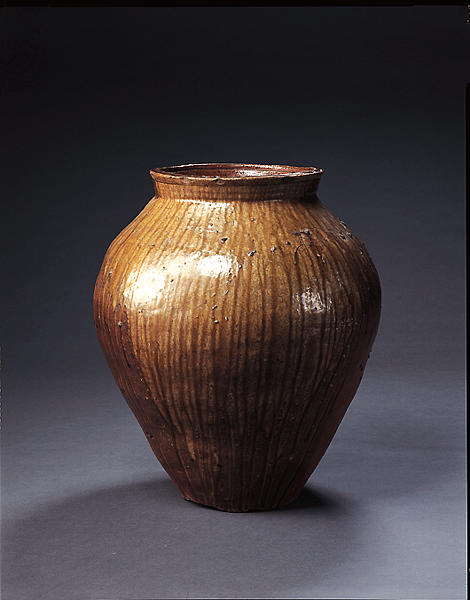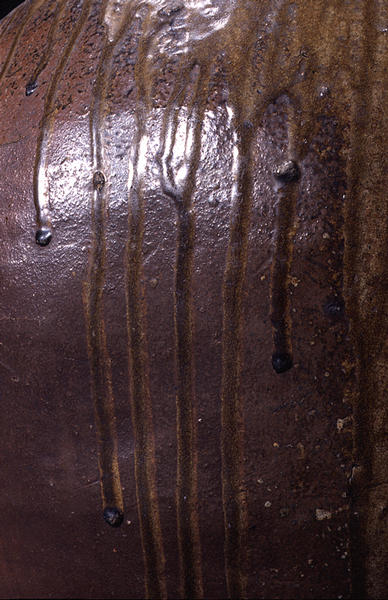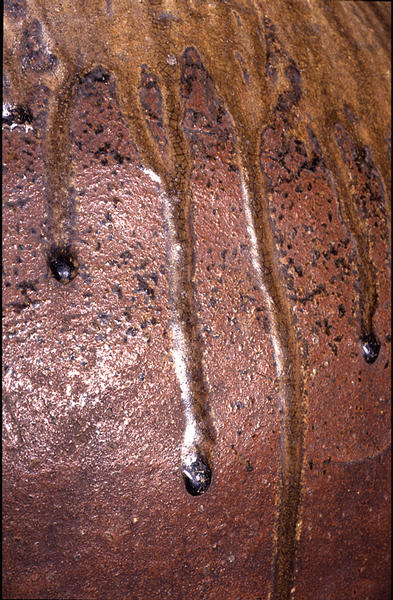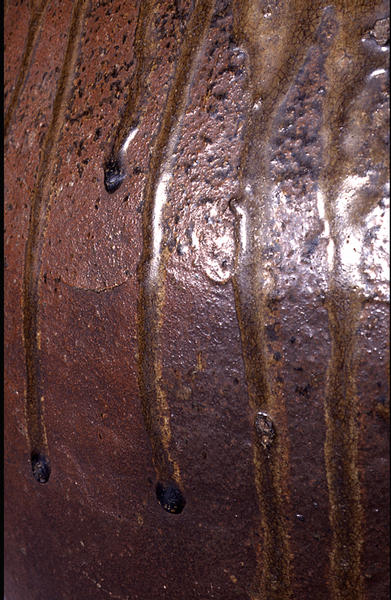越前大甕
- 福井県・越前窯
- 室町時代後期
- 16c
- 自然釉陶製
- H-68 D-59
室町時代後期 16世紀
高:68.0cm 口径:36.5cm 胴径:59.0cm 底径:25.0cm
16世紀は中世窯業のなかでいわゆる六古窯を中心とする生産体制が確立する時期である。そのなかにあって大甕生産にその特色を発揮したのは越前と備前である。越前窯では14世紀代に織田町から宮崎村,武生市にかけて広範に展開したが,15世紀代の終わり頃には北部の織田町に集約されるようになった。とくに16世紀代には従来の窖窯から大規模な大窯に転換し,織田町の岳ノ谷窯において集中生産が行われ,大型の壷・甕類が大量に焼かれている。
この大甕は岳ノ谷窯の製品とみてよいものであろう。短く外開きになった口頚部の上面にはやや幅広い面取りが施され,外面の少し下がったところにかつてのN字状口縁の痕跡を残している。胴は撫で肩で,小さな底部に向けてまっすぐに落ちる成形はこの時期の特色をよく示している。肩に箆描きの窯印が施されている。この大甕の特色は何と言っても器面全体に流れ落ちるように掛かった自然釉の見事さであろう。やや酸化して黄褐色を呈しているのもこの時期の自然釉の特色である。(楢崎)
越前窯(えちぜん)
福井県織田町(おたちょう)、宮崎村を中心に170基以上の窯が分布する中世以降の北陸地方最大の窯業地です。平安時代末期に常滑窯の影響を受けて成立したといわれています。中世には壺、甕などの無釉陶器を生産し、鎌倉時代後期から室町時代にかけて最盛期を迎えました。その流通圏は日本海沿岸を中心に北海道から鳥取県に及んでいます。室町時代後期以後、窖窯から地上式の大窯に移行しました。
越前大甕
窖窯(あながま)
丘陵の斜面をくり抜くか細長い溝を掘って上部を被せるかしてスサ入り粘土で天井と側壁を塗り込めて作る地下ないし半地下式の窯で、地表の傾斜を利用して炎の引きを強くして高温を得る仕組みです。5世紀中頃に朝鮮から伝えられた須恵器窯に始まる古代・中世を代表するわが国最初の本格的な窯で、16世紀に大窯にとって替わられるまで続きました。
越前大甕
大窯(おおがま)
窖窯に替わって室町時代後期の出現した半地上式の窯です。地方によってその形態は異なりますが、窖窯と比べて面積、体積が2倍以上も大きいものです。
越前大甕
岳ノ谷窯(だけのだん)
福井県丹生郡織田町(おたちょう)に分布する越前古窯跡のうち、天王川西部丘陵に広がる古窯7支群のひとつ、大釜屋支群の一小支群の古窯跡です。越前古窯の第5期(室町時代後期)にあたります。1986・87年に発掘調査が行われた岳ノ谷窯1号窯は全長27メートルもの大窯でした。
Catalogue Entry
Late Muromachi period, 16th century
Echizen ware, natural ash glaze
Height, 68.0cm; mouth diameter, 36.5cm;
torso diameter, 59.0cm; base diameter, 25.0cm
The so-called Six Ancient Kilns production structure was established among the kilns of Japan during the 16th century. Echizen and Bizen were the 2 kiln areas which excelled in the production of large jars. The Echizen kilns developed during the 14th century in the broad region that stretches from present-day Ota-cho to Miyazaki-mura and Takefu city, but around the end of the 15th century, this production area concentrated in Ota-cho in the north of this region. There was a shift, particularly during the 16th century, away from the previous form of anagama kiln to large-scale ogama kilns, and production centered on the Dakenodan kiln in Ota-cho where a great number of large jars and large, wide-mouthed jars were produced.
This wide-mouthed jar can be considered a product of the Dakenodan kiln. The short, outward-turning neck-to-mouth area displays a relatively wide spread on the upper edge, and traces of an N-shaped mouth rim remain just below the top of the outer edge of the mouth. The shoulders flow smoothly into the torso and then the torso falls in a straight diagonal line to the small base. These are able representations of this period's characteristic form. A spatula-drawn kiln mark is visible on the shoulder of the work. The principal characteristic of this large wide-mouthed jar is the splendid flow of natural ash glaze that covers the entire upper half of the vessel. The somewhat oxidized character of the glaze and its yellowish brown color is characteristic of the natural ash glazes of this period. SN



